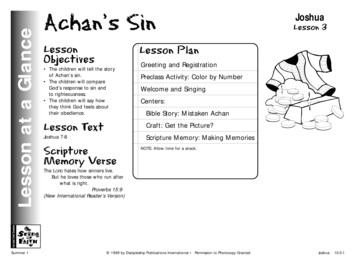
Transcription
Downloadable Reproducible eBooksThank you for purchasing this eBook fromwww.socialstudies.com or www.writingco.com. To browse more eBook titles, visithttp://www.socialstudies.com/ebooks.htmlTo learn more about eBooks, visit our help page athttp://www.socialstudies.com/ebookshelp.htmlFor questions, please e-mail eBooks@socialstudies.com Free E-mail Newsletter–Sign up Today!To learn about new eBook and print titles, professionaldevelopment resources, and catalogs in the mail, sign up forour monthly e-mail newsletter athttp://socialstudies.com/newsletter/
MP3465Grades 5-8MILLIKEN PUBLISHING COMPANY, ST. LOUIS, MISSOURI
Inside IslamInside Islam provides a detailed and richly illustrated overview of the originsand development of Islam—its history, faith, teachings, and practices. Beginningin pre-Islamic Arabia, the book traces the dramatic story of the life and legacy ofMuhammad—the rise of a tiny religious community at Medina to a vast Islamicempire with holdings that spanned the globe.The often controversial role ofMuslim women is covered, as well as Islam’s invaluable artistic, scholarly, andscientific achievements. Discussion and essay questions, word lists for vocabularyreinforcement, a test, answer key, and bibliography are included.About the Author:KATHY ZAUN holds degrees in Journalism and French and a Master's inEducation. She has been writing children's educational materials for morethan 13 years. Kathy and her husband,Todd, live in Jacksonville, Florida,with their four sons, Max,Tanner, Spencer, and Briggs.MP3465 Inside IslamWritten by: Kathy ZaunEdited by: Lisa MartyIllustrated by: Art KirchhoffLayout & Design: Jon DavisCover Photo by: Christine Osborne PicturesCopyright 2002Milliken Publishing Company11643 Lilburn Park DriveSt. Louis, MO 63146www.millikenpub.comPrinted in the USA.All rights reserved.Permission to reproduce pages extends only to teacher-purchaser for individual classroom use, not to exceed inany event more than one copy per pupil in a course.The reproduction of any part for an entire school or schoolsystem or for commercial use is strictly prohibited.
CONTENTSAN OVERVIEW OF ISLAM . . . . . . . . . . . . . . . . . . . . . . . . . . . . . . . . . . . . . . . . . . . . . . . . . . . . . . . . . .1CHAPTER ONE — The Development of Islam . . . . . . . . . . . . . . . . . . . . . . . . . . . . . . . . . . . . . . . . . .2Life Before Muhammad . . . . . . . . . . . . . . . . . . . . . . . . . . . . . . . . . . . . . . . . . . . . . . . . . . . . . . . .3Muhammad—The Great Prophet . . . . . . . . . . . . . . . . . . . . . . . . . . . . . . . . . . . . . . . . . . . . . . . . .2The Middle East . . . . . . . . . . . . . . . . . . . . . . . . . . . . . . . . . . . . . . . . . . . . . . . . . . . . . . . . . . . . . .5CHAPTER TWO — The Spread of Islam . . . . . . . . . . . . . . . . . . . . . . . . . . . . . . . . . . . . . . . . . . . . . .6The Caliphs (632 – 661) . . . . . . . . . . . . . . . . . . . . . . . . . . . . . . . . . . . . . . . . . . . . . . . . . . . . . . .6The Umayyads (661 – 750) . . . . . . . . . . . . . . . . . . . . . . . . . . . . . . . . . . . . . . . . . . . . . . . . . . . . .7The Beginning of Islam Expansion . . . . . . . . . . . . . . . . . . . . . . . . . . . . . . . . . . . . . . . . . . . . . . .7The Abbasids (750 – 1258) . . . . . . . . . . . . . . . . . . . . . . . . . . . . . . . . . . . . . . . . . . . . . . . . . . . . .8The Crusades: A Fight for the Holy Lands . . . . . . . . . . . . . . . . . . . . . . . . . . . . . . . . . . . . . . . . . .9The Mongols . . . . . . . . . . . . . . . . . . . . . . . . . . . . . . . . . . . . . . . . . . . . . . . . . . . . . . . . . . . . . . .10Three Powerful Muslim Monarchies . . . . . . . . . . . . . . . . . . . . . . . . . . . . . . . . . . . . . . . . . . . . . .11I. The Ottoman Empire . . . . . . . . . . . . . . . . . . . . . . . . . . . . . . . . . . . . . . . . . . . . . . . . . .11II. The Safavid Dynasty . . . . . . . . . . . . . . . . . . . . . . . . . . . . . . . . . . . . . . . . . . . . . . . . . . .11III. The Mughal Empire . . . . . . . . . . . . . . . . . . . . . . . . . . . . . . . . . . . . . . . . . . . . . . . . . . .12The Rise of the West: Colonialism and its Aftermath . . . . . . . . . . . . . . . . . . . . . . . . . . . . . . . . . .12CHAPTER THREE — Teachings and Practices . . . . . . . . . . . . . . . . . . . . . . . . . . . . . . . . . . . . . . . .14The Quran . . . . . . . . . . . . . . . . . . . . . . . . . . . . . . . . . . . . . . . . . . . . . . . . . . . . . . . . . . . . . . . . .14The Mosque . . . . . . . . . . . . . . . . . . . . . . . . . . . . . . . . . . . . . . . . . . . . . . . . . . . . . . . . . . . . . . . .15The Five Pillars of Islam . . . . . . . . . . . . . . . . . . . . . . . . . . . . . . . . . . . . . . . . . . . . . . . . . . . . . .17Pillar I – The Shahada . . . . . . . . . . . . . . . . . . . . . . . . . . . . . . . . . . . . . . . . . . . . . . . . . . . . . .17Pillar II – Salat . . . . . . . . . . . . . . . . . . . . . . . . . . . . . . . . . . . . . . . . . . . . . . . . . . . . . . . . . . .18Pillar III – Zakat . . . . . . . . . . . . . . . . . . . . . . . . . . . . . . . . . . . . . . . . . . . . . . . . . . . . . . . . . .18Pillar IV – Sawm . . . . . . . . . . . . . . . . . . . . . . . . . . . . . . . . . . . . . . . . . . . . . . . . . . . . . . . . .18Pillar V – Hajj . . . . . . . . . . . . . . . . . . . . . . . . . . . . . . . . . . . . . . . . . . . . . . . . . . . . . . . . . . .19CHAPTER FOUR — Islamic Law . . . . . . . . . . . . . . . . . . . . . . . . . . . . . . . . . . . . . . . . . . . . . . . . . . .20Sharia. . . . . . . . . . . . . . . . . . . . . . . . . . . . . . . . . . . . . . . . . . . . . . . . . . . . . . . . . . . . . . . . . .20Muslim Actions . . . . . . . . . . . . . . . . . . . . . . . . . . . . . . . . . . . . . . . . . . . . . . . . . . . . . . . . . . . . .20Sin and God’s Forgiveness . . . . . . . . . . . . . . . . . . . . . . . . . . . . . . . . . . . . . . . . . . . . . . . . . . . . .21Good Deeds . . . . . . . . . . . . . . . . . . . . . . . . . . . . . . . . . . . . . . . . . . . . . . . . . . . . . . . . . . . .21Major Sins . . . . . . . . . . . . . . . . . . . . . . . . . . . . . . . . . . . . . . . . . . . . . . . . . . . . . . . . . . . . . .21CHAPTER FIVE — Women in Islam . . . . . . . . . . . . . . . . . . . . . . . . . . . . . . . . . . . . . . . . . . . . . . . . .22Men and Women Are Equal—Or Are They . . . . . . . . . . . . . . . . . . . . . . . . . . . . . . . . . . . . . . . . .22Muslim Women and What They Wear . . . . . . . . . . . . . . . . . . . . . . . . . . . . . . . . . . . . . . . . . . . . .23CHAPTER SIX — Islamic Sects . . . . . . . . . . . . . . . . . . . . . . . . . . . . . . . . . . . . . . . . . . . . . . . . . . . .24Sunnis and Shiites . . . . . . . . . . . . . . . . . . . . . . . . . . . . . . . . . . . . . . . . . . . . . . . . . . . . . . . . . . .24Sufism. . . . . . . . . . . . . . . . . . . . . . . . . . . . . . . . . . . . . . . . . . . . . . . . . . . . . . . . . . . . . . . . . .25CHAPTER SEVEN — Arab Contributions . . . . . . . . . . . . . . . . . . . . . . . . . . . . . . . . . . . . . . . . . . . . .26Islamic Architecture . . . . . . . . . . . . . . . . . . . . . . . . . . . . . . . . . . . . . . . . . . . . . . . . . . . . . . . . . .26Islamic Art . . . . . . . . . . . . . . . . . . . . . . . . . . . . . . . . . . . . . . . . . . . . . . . . . . . . . . . . . . . . . . . . .27Arabic Literature . . . . . . . . . . . . . . . . . . . . . . . . . . . . . . . . . . . . . . . . . . . . . . . . . . . . . . . . . . . .30Arabic Contributions to Science . . . . . . . . . . . . . . . . . . . . . . . . . . . . . . . . . . . . . . . . . . . . . . . . .32CHAPTER EIGHT — Islamic Holy Festivals and Holy Days of Observance . . . . . . . . . . . . . . . . .34CHAPTER NINE — A Comparison of Islam with Other World Religions . . . . . . . . . . . . . . . . . . .35TEST . . . . . . . . . . . . . . . . . . . . . . . . . . . . . . . . . . . . . . . . . . . . . . . . . . . . . . . . . . . . . . . . . . . . . . . . .39ANSWER KEY . . . . . . . . . . . . . . . . . . . . . . . . . . . . . . . . . . . . . . . . . . . . . . . . . . . . . . . . . . . . . . . . . .42BIBLIOGRAPHY & INTERNET SITES . . . . . . . . . . . . . . . . . . . . . . . . . . . . . . . . . . . . . . . . . . . . . . . . . .47Inside Islam Milliken Publishing Company
AN OVERVIEWIOF ISLAMslam is a religion that developed almost 1400 years ago in Mecca (in present-daySaudi Arabia). Today, Islam is the second largest and fastest growing religion in theworld. Approximately 1.3 billion Muslims can be found in 55 different countries.Between four and seven million Muslims are United States citizens.Islam is an Arabic word, the root of which (s-l-m) primarily means “peace,” but in asecondary sense means “surrender.” In its broadest sense, the word Islam means “thepeace that comes when one’s life is surrendered to God.” Muslims submit to God,called Allah in Arabic, and follow Islamic teachings.Islam is a way of life based on the teachings of the prophet Muhammad who livedfrom 570—632. Muhammad is believed by Muslims to have received revelations fromGod. These revelations were assembled in a book called the Quran (also, Koran),which Muslims believe contains the actual word of God. The Quran is the Muslim holybook, containing the guidelines by which followers of Allah are to live, which cannotbe changed or added to.Islam provides guidelines for the moral, spiritual, and political organization ofsociety. Thus, Muslims believe all actions must be guided by God’s will.The fundamental concept of Islam is monotheism—the belief that there is oneGod,Allah—and Muhammad is his messenger and servant. God requires both moralbehavior and devotion from Muslims. Muslims believe that they were created toworship and serve God and humanity.Muslims have six fundamental beliefs called the articles of faith.The six beliefs are:belief in Allah, belief in angels, belief in the previously revealed books of God, belief inall the prophets, belief in the Day of Judgment, and belief in divine laws.Words to les of faith1Inside Islam Milliken Publishing Company
CHAPTER ONEThe Development of IslamLife Before MuhammadBefore Islam, people living in theMiddle East (see map on page 5) wereknown as Arabs, as they are today.Theirnative language was and still is Arabic.AllArabs share a common history and culture.Arabs before Islam were traders,farmers, nomads, and town-dwellers.Theyhad many religions and worshiped anumber of gods.Muslim history begins with the storyof Abraham, a prophet. It is believed thatAbraham may have lived between 2100and 1500 B.C. He is regarded by Muslims(and Jews) as the father of their people.Abraham is also considered to be the firstmonotheist (believer in one God).Abraham and his wife’s servant,Hagar, had a son named Ishmael. Hagarand Ishmael were sent away whenAbraham’s wife, Sarah, had a son, Isaac.Hagar and Ishmael traveled to whatcame to be called the city of Mecca (thebirthplace of Islam). There they found asacred well. This well provided themwith the water they needed to live.When Ishmael grew to be an adult,Abraham visited him in Mecca. There,next to the sacred well,Abraham andIshmael (a prophet, like his father) built atemple to God.This temple is called theKaaba. It is the holiest shrine of theIslamic faith. In the wall of the Kaaba, thetwo prophets placed the Black Stone.Muslims believe the Black Stone fell fromheaven as a sign of the first covenantbetween God and humankind.Although the Kaaba was built as atemple to God, many Arabs before Islamfilled it with idols that represented anumber of gods. These Arabs then madepilgrimages there to worship the idols.It was not until Muhammad conqueredMecca, in 630, that the Kaaba wascleansed of its idols and returned to itsoriginal state of holiness as a temple tothe one God of Islam—Allah.Muhammad – The Great ProphetIslam began with the prophetMuhammad.Although Muhammad (hisname means “the praised one”) is not thefirst Islamic prophet, he is believed byMuslims to be the last.The Quran citesAdam as the first prophet, with thousandsfalling between Adam and Muhammad,but only 25 listed by name. Some ofthose listed by name include Abraham,Moses, David, and Jesus.Muhammad was aware of Hebrewand Christian traditions and believed thatGod had already revealed himself in partthrough Moses and Jesus. However,Muhammad believed he was chosen tobe God’s messenger to deliver the finalrevelations of God to the people.Muhammad was born in the Arabiancity of Mecca, near the coast of the RedSea in about 570.According to tradition,Inside Islam Milliken Publishing CompanyAbraham’s banishmentof Hagar and Ishmael isa pivotal moment in thehistory of monotheism.Jews and Muslims bothclaim Abraham as theirpatriarch. Muslimsbelieve themselvesdescendants of Abrahamthrough Ishmael, andJews through Isaac.Words to remember:ArabsAbrahamHagarIshmaelMeccaKaabaBlack StoneidolAllahQuran2
There, one night, at age 40, in about610, Muhammad is said to have receivedthe first of his revelations from God.Theangel Gabriel appeared to him andcommanded him to recite words thatlater became part of the Quran.“Recite,”Gabriel said,“in the name of the Lordwho created man from clots of blood.Your Lord is the Most Bountiful One,who by the pen taught man what he didnot know.”Initially frightened, Muhammad cameto accept the revelations which werefrom then on frequently imparted to him.In 613, Muhammad began preaching themessage of monotheism—a belief in theone true God. He also taught that idolatrywas wrong.This concept was highlycontroversial, as Arabs had beenworshipping a number of gods for manyyears.At first, Islam was merely a localreligion led by Muhammad, and Meccanstolerated his preaching. Some laughed atMuhammad and thought his teachingsodd. But as he grew more confident anduncompromising, condemning theidolatry and immorality of his fellowtownsmen, Muhammad was increasinglyseen as a danger to the existing way of lifeand a threat to the Meccan economy.Merchants, in particular, feared that if Arabsbecame followers of Muhammad andstopped making pilgrimages to Mecca toworship idols at the Kaaba, they wouldstop spending money there, and theon the night of his birth, a star filledthe sky with a bright light.Muhammad’s parents died when hewas young, so he was raised by hisuncle.As a young man, Muhammadworked as a trade agent for a wealthywidow.At the age of twenty-five, heAccording to Islam, theangel Gabriel spoke toMuhammad.Words to remember:Muhammadrevelationsangel �s Tombmarried this woman (who was fifteenyears older than he) and had severalchildren with her.Muhammad was a successful caravanmerchant. In the course of his manyjourneys, Muhammad had repeatedencounters with Jews and Christians.Through them, he became interested inreligious questions and grew increasinglyuncomfortable with worldliness, greed,and the pagan worship in Mecca. Hebegan to meditate in a cave on themountain, Hira, outside the city.The Life of Muhammad (570–632)570594610Muhammad is bornin Mecca.613620 622Muhammad marries awealthy widow;becomes aprosperous merchant.3The angel Gabrielappears to Muhammadas he meditates in acave outside Mecca.This is the first ofmany revelationsMuhammad receivesover a period of about23 years.Inside Islam Milliken Publishing CompanyAbout 10 years afterMuhammad beganhis ministry, heexperiences what isknown as the“Night Journey.”.630632Muhammad diesin Medina.Muhammad beginspreaching that Allahis the only God.Muhammad is forcedout of Mecca; he andhis followers migrateto Medina (Hegira);Hegira is celebratedas the beginning ofIslam as an organizedreligion and it alsosignifies thebeginning of theIslamic calendar.Muhammad conquersMecca; rids the Kaabaof idolatry and returnsit to its original stateas a temple to theone God, Allah.
merchants would no longer prosper. So,Muhammad and his followers werepersecuted for their beliefs and for theirdisruption of Meccan life.Fleeing persecution, Muhammadorganized an exodus out of Mecca in 622.He and his small band of followers movedto the nearby city of Medina, 250 milesnorth, where they were welcomed.Thismigration is known as the Hegira. Thismomentous event is important for tworeasons: it signifies the beginning of theIslamic calendar; and it recognizes thebeginning of Islam as an organized religion.While Muhammad was in Medina, heattempted to form alliances with Jewsand Christians there on the basis of whathe believed to be strong common elementsin these three monotheistic religions.When his overtures failed, Muhammadbegan to define Islam differently. Hechanged the direction of prayer fromJerusalem to Mecca—an act whose politicalramifications are still being felt today.A skilled military leader, Muhammadresisted attacks on Medina by forces fromMecca and successfully led his ownattack on Mecca with an army of 10,000men in 630. Many people who oncerejected Islam now embraced it.Muhammad ordered the destruction ofidols that surrounded the Kaaba andrestored the site to its original state—atemple to the one and only God,Allah.Today, the Kaaba is Islam’s holiest site.Not long after Muhammad realizedhis quest for an Arab Islamic state—heruled almost the entire Arabian peninsula—he died in Medina unexpectedly of feveron June 8, 632. His tomb in Medina isknown as the Prophet’s Tomb and it,too,is one of Islam’s holy sites.Section Review1. How is Islam similar to Christianityand Judaism?2. How is the role of prophet differentin Islam than in other religions?3. How is Muhammad different fromother prophets you are familiar with?4. How is Islam similar to your religion?5. Why do you think Islam was fearedand rejected at first?Muhammad was askilled military leaderas well as a prophet.Essay Ideas:1. Compare Islam’s holiest site (Kaaba) to a site you consider holy. Do you feelsuch sites are important, or perhaps irrelevant? Why?2. Islam emphasizes moral behavior.What morals, if any, do you feel our societylacks today? If so, what do you feel has contributed to this situation? How doyou think these can be reinstated?3. People often stereotype people of other religions.What could you do to helpdispel some of these stereotypes?4. Name some material objects you feel people in our society worship.Tell whyyou think these things are worshiped.5. Write about people today whom you feel are persecuted for their beliefs.6. Imagine that God sent an angel with a message for you to give to the world.What might that message be?Inside Islam Milliken Publishing Company4
The Middle EastIslam originated in an area known today as the Middle East.The Middle East ishome to a large group of people known as Arabs who speak Arabic as their nativelanguage and share a common culture and history. Smaller ethnic groups living inthis area include Iranians,Turks,Armenians, Copts, Jews, Greeks, and Kurds. Morethan 90 percent of all people living in the Middle East are Muslims.WhileChristianity and Judaism were also founded in the Middle East, Christiansmake up 7 percent of the population and Jews only 1 percent.1. Mecca is the birthplace of Islam. Look at this area on the map(left). Now circle the same area in blue on the map below andwrite its modern-day name.The map above showsthe geographic areaknown as Arabiain the year 610.2. The Middle East covers parts of northern Africa, southwestern Asia,and southeastern Europe. Scholars disagree on which countriesmake up the Middle East. Many say the region is comprised ofthese 17 countries: Bahrain, Cyprus, Egypt, Iran, Iraq, Israel,Jordan, Kuwait, Lebanon, Oman, Qatar, Saudi Arabia, Sudan, Syria,Turkey, United Arab Emirates, and Yemen. About 262 million people live inthis area. Label these countries on the map below.3. Pakistan, India, and Afghanistan also have large Muslim populations.Label these countries in green on the map below.CaspBlack SeaianSeaMediterraneanSeaRedSeaArabianSea5Inside Islam Milliken Publishing Company
CHAPTER TWOThe Spread of IslamThe Caliphs (632 – 661)Muhammad’s death in 632 createda problem for the Muslim community.Muhammad had no sons and had notappointed a successor.Thus, in keepingwith Arab tradition, upon his death,Muhammad’s closest disciples met toelect his replacement.His followersdisagreed about whom their new leadershould be. (Later you will see how thisissue divided the Muslim world.)A caliph (from the Arabic wordkhalifah meaning “successor,” or“representative”) is the secular andreligious leader of the Islamic community.Caliphs are elected for life.The firstfour caliphs (or successors ofMuhammad) are known as the RightlyGuided Caliphs.They are called thisbecause each one was believed to havelead an exemplary life and to haveworked hard to help Muhammad achievehis goal—spreading Islam to other lands.These caliphs included Abu Bakr, Umar,Uthman, and Ali.They ruled from the cityof Medina.The first caliph,Abu Bakr, wasMuhammad’s father-in-law—the father ofhis second wife. He ruled for two years(632–634).Though Abu Bakr did notgreatly expand Islam, he was able tosubdue revolts led by various Arabiantribes. Muslims were successful inconverting these tribes to Islam.Before Abu Bakr died in 634, henamed Umar as his successor. Umar ruledfor 10 years (634–644). During this time,the Arabs were intent on conqueringneighboring peoples. Umar made it hisgoal to conquer the Middle East.At theend of his rule, Muslims had conqueredSyria, Palestine, Egypt, and most of Iraq.(Refer to the map on page 5 that depictsthe Middle East.)Uthman was appointed caliph afterUmar. He ruled from 644 to 656. DuringUthman’s rule, Muslims completed theirconquest of Iran and spread Islam acrossnorthern Africa. However, it was alsoduring this time that Muslim political andreligious unity ended due to the eruptionof political conflicts. Uthman’s enemiesaccused him of caring too much aboutwealth and material things. Eventually, hewas killed.The last of the Rightly GuidedCaliphs was Ali, who ruled from 656 to661.As Muhammad’s son-in-law, he wasthe closest living relative to Muhammad.He had been asked to be the third caliph,but had refused.When asked a secondtime,Ali agreed to rule.By the end of their rule, the RightlyGuided Caliphs had been successful inconverting the peoples of many lands toInside Islam Milliken Publishing CompanyWords to remember:CaliphRightly GuidedCaliphs:Abu Bakr, Umar,Uthman, AliMedinaThe map below showsthe growth of the Islamicstate during the reign ofthe Rightly Guided Caliphs.Compare it to the mapof the Middle East todayon page 5.6
Islam.They also helped create a vastnew Islamic empire that was controlledby Arabian Muslims.Section Review:1. How were the Rightly GuidedCaliphs successful?2. What does the word caliph mean?The Umayyads (661 – 750)After the four Rightly GuidedCaliphs, the Umayyad dynasty of caliphsruled the Islamic empire. From this timeon, the position of caliph was an inheritedone.The Umayyads did not rule fromMedina like their predecessors.Theymade Damascus their capital.The Beginning of Islam ExpansionThe map below depicts the areas to which Islam spread from the time ofMuhammad’s death to the fall of the Umayyad caliphs.After reading the informationbelow, create a map key to identify the land acquisitions of each ruling group. Besure to include dates in your map key.1. At the time of Muhammad’s death (632), Islam was practiced by Muslimsliving in Arabia.2. By the end of their rule, the Rightly Guided Caliphs (632–661) had succeededin spreading Islam across North Africa, Egypt, Syria, Palestine, Iran, and Iraq.3. The Umayyads (661–750) continued conquering lands and converting peopleto Islam. Their empire included North Africa and Spain (west) andAfghanistan and central Asia (east).4. Label the country that defeated the Muslims at the Battle of Tours, plus allbodies of water.7Inside Islam Milliken Publishing Company
Under the Umayyads, the Islamicstate developed into an imperial power.The Muslims expanded their empire toinclude Afghanistan and central Asia inthe east and across northern Africa andinto Spain in the west.This expansion ofIslam greatly increased the number ofnon-Arab Muslims. (An attempt was alsomade to conquer France at the Battle ofTours. However, the French, underCharles Martel, defeated the Muslims.Many historians view this battle as oneof the most important ever foughtbecause it resulted in Christianity, notIslam, becoming the dominant religionin Europe.)The Umayyad caliphs lived more likekings than religious leaders.Theyreorganized the government and createdpostal routes.They built magnificentmosques. And though these changeswere beneficial for many Muslims, theyalso ultimately led to the destruction ofthe Umayyads.The vast Umayyad empire wasbesieged by many social and economicproblems. Some of these problemsstemmed from the newly conqueredpeoples. For the first time, many newIslamic lands contained more non-ArabMuslims than Arab Muslims.These newMuslims were not chosen for importantgovernment jobs, had to pay highertaxes, and earned less money for servingin the army than Arab Muslims.This madethe non-Arab Muslims angry and led tomany revolts against the Umayyads.Further complicating matters, theMuslim religion suffered internaltheological and political disputes thatresulted in a splintering of the religioninto two groups—the Shiites, whobelieved only descendants of Ali (the lastof the Rightly Guided Caliphs and adescendant of Muhammad) should holdthe title of caliph, and the Sunnis whobelieved that any sufficiently pious andqualified person could be caliph.Dissension was apparent in many areasof the Arab Empire.Eventually, a group of Muslims calledthe Abbasids began to strongly supportthe new Muslims.The Abbasidsbelieved the new Muslims should havethe same rights as the Arabs, regardlessof their ethnic background. In 750, theyoverthrew the Umayyads.Thus began therule of the Abbasids.Their rule lasteduntil 1258.Section Review:1. What two branches of Islam formedduring Umayyad rule and why?2. What caused the fall of the Umayyaddynasty?The Abbasids (750 – 1258)The Abbasids ruled the Arab EmpireWords to remember:Umayyadsimperial powerAbbasidsBattle of Toursnon-ArabMuslims/new MuslimsSunnisShiitesfrom 750 to 1258. Their first 100 yearsis called the Golden Age of Islam. It wasduring this period that many positivechanges occurred in the empire.Afterthis time, many problems arose amongthe Muslims and their leaders.Unlike the Umayyads, the Abbasidsdid not strive to greatly expand theirempire. It had already grown so large,that they had to work hard to keep itunited.As it was, an Arab no longermeant “a person from Arabia.”At thispoint, an Arab signified someone whospoke Arabic. Basically, the only Arabinfluence left in the Arab Empire was theIslamic religion and the Arabic language.The many new cultures and customs thathad been acquired during expansion hadcreated a whole new kind of Arab.So instead of focusing on greaterexpansion of the empire, the Abbasidsfocused on turning Baghdad, Iraq, into amajor world trading center.To accomplishthis goal, the Abbasids first moved thecapital of the Arab empire fromDamascus to Baghdad in 762. Here, thecentralized monarchy of the Abbasidsoperated from a huge complex called theCity of Peace.This complex included agreat mosque, the caliph’s incrediblepalace, and the magnificent homes ofpublic officials.Inside Islam Milliken Publishing Company8
Words to remember:AbbasidsGolden Age of IslamArab (at time ofAbbasid Empire)DamascusBaghdadCity of PeacePersian GulfEuphrates RiverSufismmysticsSeljuk TurksMongols9To further aid in the creation of agreat trading center, the Abbasids tookadvantage of the Persian Gulf and theEuphrates River for transporting goods.Products came from east Africa,Arabia,India, southeast Asia, and China by way ofthe Persian Gulf. Goods from northernAfrica, Egypt, and the Mediterraneanflowed along the Euphrates River. Baghdadbecame the center of an enormous tradeempire.Due to the increased number ofcountries trading in Baghdad, Islamic artsand sciences also flourished during therule of the Abbasids. Works of such greatGreek philosophers as Plato and Aristotlewere translated into Arabic; several schoolsof Islamic law were created; a researchlibrary called the House of Wisdom wasestablished; and the Quran and Arabicgrammar were big topics of study.With access to many different partsof the world, life changed rapidly anddramatically in the Arab empire.Trademade many Arabs wealthy. Even farmersprospered, thanks to advances in farmingmethods.And new customs evolved. Forexample, rather than wearing thecustomary Arab robe, men began wearingpants.Also new under Abbasid rule was theemergence of Sufism. (Sufis are Islamicmystics who take vows of poverty andperform acts of physical deprivation suchas fasting and going without sleep inorder to achieve a more perfect unitywith God. See Chapter 6 for a morelengthy discussion.) Sufis can be Sunnisor Shiites.With all of the changes that tookplace in the Arab empire under theAbbasids, it is no surprise that ruling theArab empire was becoming too much forone caliph. The empire was so large thatit began breaking up into smaller,independent kingdoms. From 929 to1031, three caliphs were ruling in theempire.There were the Abbasids in Iraq,the Umayyads in Spain, and anothercaliph dynasty in northern Africa. In fact,from the mid-900s until the fall of theInside Islam Milliken Publishing CompanyAbbasids, many caliphs were consideredweak leaders, often forced to follow thecommands of powerful military dictators.Also during this time of weakness,groups of Muslim Turks from central Asiabegan invading the Arab empire.Themo
Free E-mail Newsletter–Sign up Today! To learn about new eBook and print titles, professional . peace that comes when one’s life is surrendered to God.”Muslims submit to God, . Abraham and his wif










